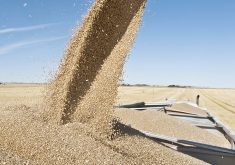BANFF, Alta. – When pigs on a farm near Rocky Mountain House, Alta., were diagnosed with the H1N1 virus last April, it sparked investigations, quarantines and attention from media outlets around the world.
It was the world’s first case of H1N1 infection in a hog herd and provided valuable lessons for public officials in how to deal with an unknown disease.
“It is not just the infection but the response that has the greatest impact for all of us,” said Julia Keenliside, a veterinary epidemiologist with Alberta Agriculture.
Read Also

Soybean market still figuring out implications of China-U.S. pact
Soybean futures had a muted reaction to the U.S. trade deal with China as the market tries to figure out the nuances of the deal.
Contrast that with the reaction to the second case that occurred later that summer on a farm with 300 sows.
The Canadian Food Inspection Agency did not quarantine the animals and the herd recovered in about 10 days.
The second event was not immediately publicized because the CFIA deemed the situation had no significant effect on human health, Keenliside told the Banff Pork Seminar
Jan. 20.
She said the CFIA doesn’t quarantine herds with pandemic H1N1, as long as there is no change in disease presentation.
In the case at Rocky Mountain House, it came at a time of heightened fears. H1N1 was making headlines because of an outbreak in Mexico.
From March to May 2009, Mexico reported 5,337 human cases and 97 deaths from H1N1.
Egan Brockhoff, the attending vet at Arnold Van Ginkel’s Rocky Mountain House area farm, found everything in order when he was called to the farm.
He said Van Ginkel was a conscientious manager, with a production unit consisting of a 220 sow, farrow-to-finish operation with a good biosecurity plan.
No new animals had entered the farm after February 2009.
Influenza had struck in 2004, but none of the pigs from that outbreak were there anymore.
There were health problems, but Brockhoff said he thought Van Ginkel had them under control with good sanitation and vaccination.
The farm was positive for porcine respiratory syndrome, mycoplasma hyopneumoniae, clinical ileitus and porcine circovirus.
“This guy was really a top notch producer and did an exceptional job of managing the pig health on his farm,” Brockhoff said.
It is not clear how the herd contracted H1N1, but a carpenter who had visited Mexico during the disease outbreak there worked on the barn’s ventilation system, and six days later Van Ginkel noticed coughing hogs in the barns where the carpenter worked.
The carpenter eventually tested positive for H1N1, even though earlier tests had cleared him.
Influenza was evident among piglets and grower pigs a week later. They had fever, deep dry coughs, redness around eyes, were moderately depressed and were off feed with mild dehydration. Few pigs died. No sows became sick.
The farm weaned 120 pigs per week, but CFIA’s quarantine prevented pigs from being shipped and space was running out. By May, 8,475 finisher pigs were euthanized and shipped for rendering.
Van Ginkel decided to get rid of all his 3,000 pigs by June 4-6 because no market would accept them.
He was compensated through the federal AgriStability and AgriRecovery programs.
The quarantine was removed July 29 and young, healthy pigs returned the following week after the barns had been sanitized.
Canada notified the World Organization for Animal Health on May 2. This was followed by a public announcement that pandemic H1N1 had been found.















